in, to, on和off在方位名词前的区别资料讲解
- 格式:doc
- 大小:21.50 KB
- 文档页数:4
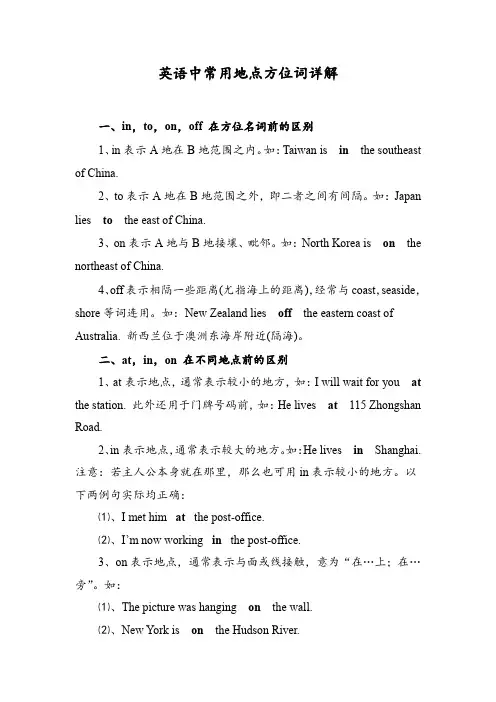
英语中常用地点方位词详解一、in,to,on,off 在方位名词前的区别1、in表示A地在B地范围之内。
如:Taiwan is in the southeast of China.2、to表示A地在B地范围之外,即二者之间有间隔。
如:Japan lies to the east of China.3、on表示A地与B地接壤、毗邻。
如:North Korea is on the northeast of China.4、off表示相隔一些距离(尤指海上的距离),经常与coast,seaside,shore等词连用。
如:New Zealand lies off the eastern coast of Australia. 新西兰位于澳洲东海岸附近(隔海)。
二、at,in,on 在不同地点前的区别1、at表示地点,通常表示较小的地方,如:I will wait for you at the station. 此外还用于门牌号码前,如:He lives at115 Zhongshan Road.2、in表示地点,通常表示较大的地方。
如:He lives in Shanghai. 注意:若主人公本身就在那里,那么也可用in表示较小的地方。
以下两例句实际均正确:⑴、I met him at the post-office.⑵、I’m now working in the post-office.3、on表示地点,通常表示与面或线接触,意为“在…上;在…旁”。
如:⑴、The picture was hanging on the wall.⑵、New York is on the Hudson River.三、near,by,beside,at 表示“在…附近”的区别1、near表示相对的近,实际距离有可能很远。
如:Suzhou is near Shanghai.2、by和beside都表示靠近,实际距离不远,但beside比by更具体地表示出“在…旁边”的意思。
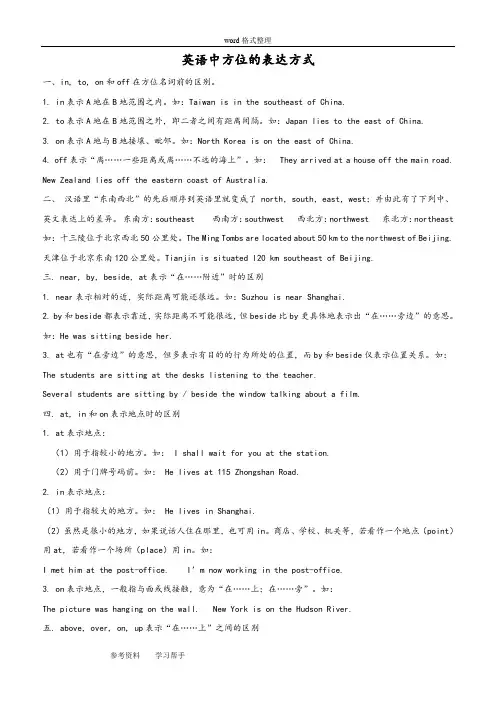
英语中方位的表达方式一、in, to, on和off在方位名词前的区别。
1. in表示A地在B地范围之内。
如:Taiwan is in the southeast of China.2. to表示A地在B地范围之外,即二者之间有距离间隔。
如:Japan lies to the east of China.3. on表示A地与B地接壤、毗邻。
如:North Korea is on the east of China.4. off表示“离……一些距离或离……不远的海上”。
如: They arrived at a house off the main road. New Zealand lies off the eastern coast of Australia.二、汉语里“东南西北”的先后顺序到英语里就变成了north,south,east,west;并由此有了下列中、英文表达上的差异。
东南方:southeast 西南方:southwest 西北方:northwest 东北方:northeast 如:十三陵位于北京西北50公里处。
The Ming Tombs are located about 50 km to the northwest of Beijing.天津位于北京东南120公里处。
Tianjin is situated l20 km southeast of Beijing.三. near, by, beside, at表示“在……附近”时的区别1. near表示相对的近,实际距离可能还很远。
如:Suzhou is near Shanghai.2. by和beside都表示靠近,实际距离不可能很远,但beside比by更具体地表示出“在……旁边”的意思。
如:He was sitting beside her.3. at也有“在旁边”的意思,但多表示有目的的行为所处的位置,而by和beside仅表示位置关系。
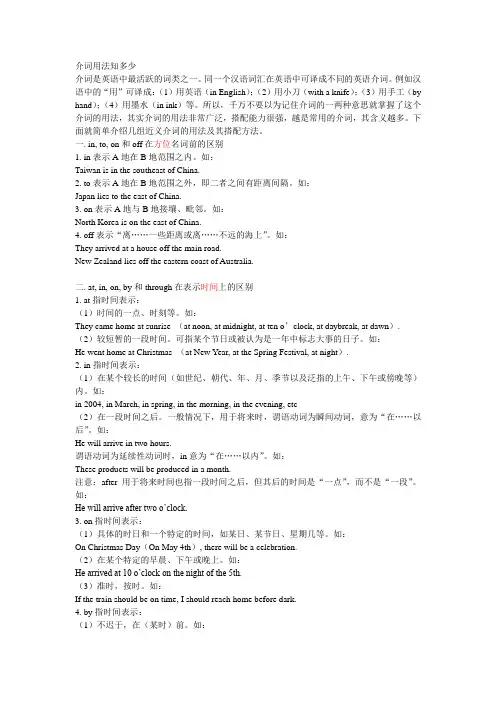
介词用法知多少介词是英语中最活跃的词类之一。
同一个汉语词汇在英语中可译成不同的英语介词。
例如汉语中的“用”可译成:(1)用英语(in English);(2)用小刀(with a knife);(3)用手工(by hand);(4)用墨水(in ink)等。
所以,千万不要以为记住介词的一两种意思就掌握了这个介词的用法,其实介词的用法非常广泛,搭配能力很强,越是常用的介词,其含义越多。
下面就简单介绍几组近义介词的用法及其搭配方法。
一. in, to, on和off在方位名词前的区别1. in表示A地在B地范围之内。
如:Taiwan is in the southeast of China.2. to表示A地在B地范围之外,即二者之间有距离间隔。
如:Japan lies to the east of China.3. on表示A地与B地接壤、毗邻。
如:North Korea is on the east of China.4. off表示“离……一些距离或离……不远的海上”。
如:They arrived at a house off the main road.New Zealand lies off the eastern coast of Australia.二. at, in, on, by和through在表示时间上的区别1. at指时间表示:(1)时间的一点、时刻等。
如:They came home at sunrise (at noon, at midnight, at ten o’clock, at daybreak, at dawn). (2)较短暂的一段时间。
可指某个节日或被认为是一年中标志大事的日子。
如:He went home at Christmas (at New Year, at the Spring Festival, at night).2. in指时间表示:(1)在某个较长的时间(如世纪、朝代、年、月、季节以及泛指的上午、下午或傍晚等)内。
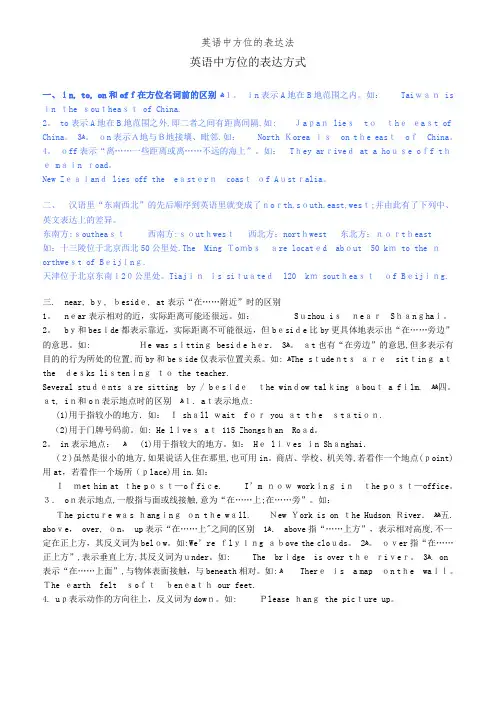
英语中方位的表达法英语中方位的表达方式一、in, to, on和off在方位名词前的区别ﻫ1。
in表示A地在B地范围之内。
如:Taiwan is in the southeast of China.2。
to表示A地在B地范围之外,即二者之间有距离间隔.如: Japan liestotheeast of China。
ﻫ3。
on表示A地与B地接壤、毗邻.如: North Korea ison the eastofChina。
4。
off表示“离……一些距离或离……不远的海上”。
如: They arrived at a house off the main road。
New Zealand lies off the easterncoastof Australia。
二、汉语里“东南西北”的先后顺序到英语里就变成了north,south,east,west;并由此有了下列中、英文表达上的差异。
东南方:southeast西南方:southwest西北方:northwest 东北方:northeast 如:十三陵位于北京西北50公里处.The Ming Tombsare located about 50 km to the northwest of Beijing.天津位于北京东南120公里处。
Tiajinis situatedl20 km southeastof Beijing.三. near, by, beside, at表示“在……附近”时的区别1。
near表示相对的近,实际距离可能还很远。
如:Suzhou isnearShanghai。
2。
by和beside都表示靠近,实际距离不可能很远,但beside比by更具体地表示出“在……旁边”的意思。
如: He was sitting beside her.ﻫ3。
at也有“在旁边”的意思,但多表示有目的的行为所处的位置,而by和beside仅表示位置关系。

常用地点方位词详解1、in, to, on, off 在方位名词前的区别1.1、in表示A地在B地范围之内。
如:Taiwan is in the southeast of China.1.2、to表示A地在B地范围之外,即二者之间有间隔。
如:Japan lies to the east of China.1.3、on表示A地与B地接壤、毗邻。
如:North Korea is on the northeast of China.1.4、off表示相隔一些距离(尤指海上的距离),经常与coast, seaside, shore 等词连用。
如:New Zealand lies off the eastern coast of Australia. 新西兰位于澳洲东海岸附近(隔海)。
2、at, in, on 在不同地点前的区别2.1、at表示地点,通常表示较小的地方,如:I will wait for you at the station. 此外还用于门牌号码前,如:He lives at 115 Zhongshan Road.2.2、in表示地点,通常表示较大的地方。
如:He lives in Shanghai. 注意:若主人公本身就在那里,那么也可用in表示较小的地方。
以下两例句实际均正确:①I met him at the post-office.②I’m now working in the post-office.2.3、on表示地点,通常表示与面或线接触,意为“在…上;在…旁”。
如:①The picture was hanging on the wall.②New York is on the Hudson River.3、near, by, beside, at 表示“在…附近”的区别3.1、near表示相对的近,实际距离有可能很远。
如:Suzhou is near Shanghai.3.2、by和beside都表示靠近,实际距离不远,但beside比by更具体地表示出“在…旁边”的意思。

介词用法知多少介词是英语中最活跃的词类之一。
同一个汉语词汇在英语中可译成不同的英语介词。
例如汉语中的“用”可译成:(1)用英语(in English);(2)用小刀(with a knife);(3)用手工(by hand);(4)用墨水(in ink)等。
所以,千万不要以为记住介词的一两种意思就掌握了这个介词的用法,其实介词的用法非常广泛,搭配能力很强,越是常用的介词,其含义越多。
下面就简单介绍几组近义介词的用法及其搭配方法。
一. in, to, on和off在方位名词前的区别1. in表示A地在B地范围之内。
如:is in the southeast of .2. to表示A地在B地范围之外,即二者之间有距离间隔。
如:lies to the east of .3. on表示A地与B地接壤、毗邻。
如:is on the east of .4. off表示“离……一些距离或离……不远的海上”。
如:They arrived at a house off the main road.lies off the eastern coast of .二. at, in, on, by和through在表示时间上的区别1. at指时间表示:(1)时间的一点、时刻等。
如:They came home at sunrise (at noon, at midnight, at ten o’clock, at daybreak, at dawn).(2)较短暂的一段时间。
可指某个节日或被认为是一年中标志大事的日子。
如:He went home at Christmas (at New Year, at the Spring Festival, at night).2. in指时间表示:(1)在某个较长的时间(如世纪、朝代、年、月、季节以及泛指的上午、下午或傍晚等)内。
如:in 2004, in March, in spring, in the morning, in the evening, etc(2)在一段时间之后。
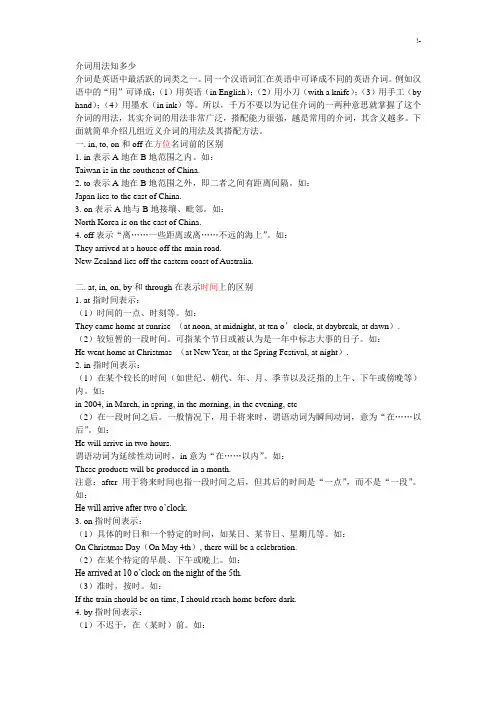
介词用法知多少介词是英语中最活跃的词类之一。
同一个汉语词汇在英语中可译成不同的英语介词。
例如汉语中的“用”可译成:(1)用英语(in English);(2)用小刀(with a knife);(3)用手工(by hand);(4)用墨水(in ink)等。
所以,千万不要以为记住介词的一两种意思就掌握了这个介词的用法,其实介词的用法非常广泛,搭配能力很强,越是常用的介词,其含义越多。
下面就简单介绍几组近义介词的用法及其搭配方法。
一. in, to, on和off在方位名词前的区别1. in表示A地在B地范围之内。
如:Taiwan is in the southeast of China.2. to表示A地在B地范围之外,即二者之间有距离间隔。
如:Japan lies to the east of China.3. on表示A地与B地接壤、毗邻。
如:North Korea is on the east of China.4. off表示“离……一些距离或离……不远的海上”。
如:They arrived at a house off the main road.New Zealand lies off the eastern coast of Australia.二. at, in, on, by和through在表示时间上的区别1. at指时间表示:(1)时间的一点、时刻等。
如:They came home at sunrise (at noon, at midnight, at ten o’clock, at daybreak, at dawn). (2)较短暂的一段时间。
可指某个节日或被认为是一年中标志大事的日子。
如:He went home at Christmas (at New Year, at the Spring Festival, at night).2. in指时间表示:(1)在某个较长的时间(如世纪、朝代、年、月、季节以及泛指的上午、下午或傍晚等)内。
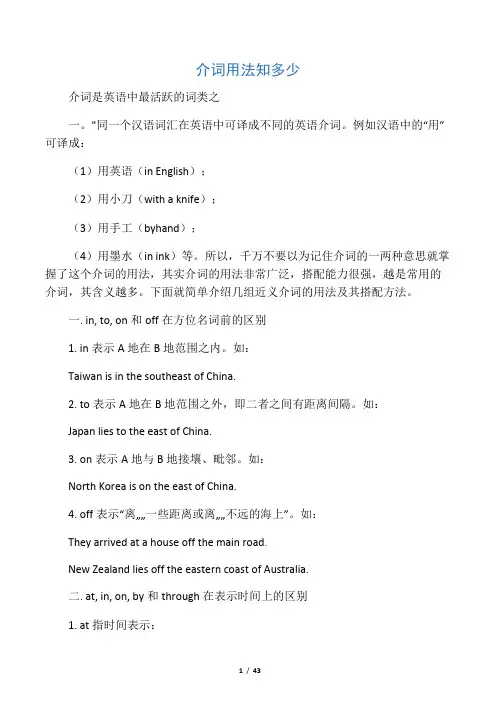
介词用法知多少介词是英语中最活跃的词类之一。
"同一个汉语词汇在英语中可译成不同的英语介词。
例如汉语中的“用”可译成:(1)用英语(in English);(2)用小刀(with a knife);(3)用手工(byhand);(4)用墨水(in ink)等。
所以,千万不要以为记住介词的一两种意思就掌握了这个介词的用法,其实介词的用法非常广泛,搭配能力很强,越是常用的介词,其含义越多。
下面就简单介绍几组近义介词的用法及其搭配方法。
一. in, to, on和off在方位名词前的区别1. in表示A地在B地范围之内。
如:Taiwan is in the southeast of China.2. to表示A地在B地范围之外,即二者之间有距离间隔。
如:Japan lies to the east of China.3. on表示A地与B地接壤、毗邻。
如:North Korea is on the east of China.4. off表示“离……一些距离或离……不远的海上”。
如:They arrived at a house off the main road.New Zealand lies off the eastern coast of Australia.二. at, in, on, by和through在表示时间上的区别1. at指时间表示:(1)时间的一点、时刻等。
如:They came home at sunrise(at noon, at midnight, at ten o’clock, at daybreak, at dawn).(2)较短暂的一段时间。
可指某个节日或被认为是一年中标志大事的日子。
如:He went home at Christmas(at New Year, at the Spring Festival, at night).2. in指时间表示:(1)在某个较长的时间(如世纪、朝代、年、月、季节以及泛指的上午、下午或傍晚等)内。
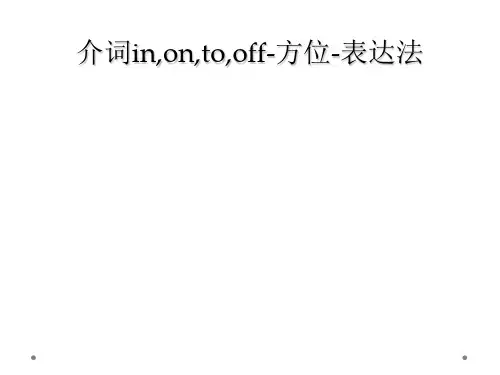
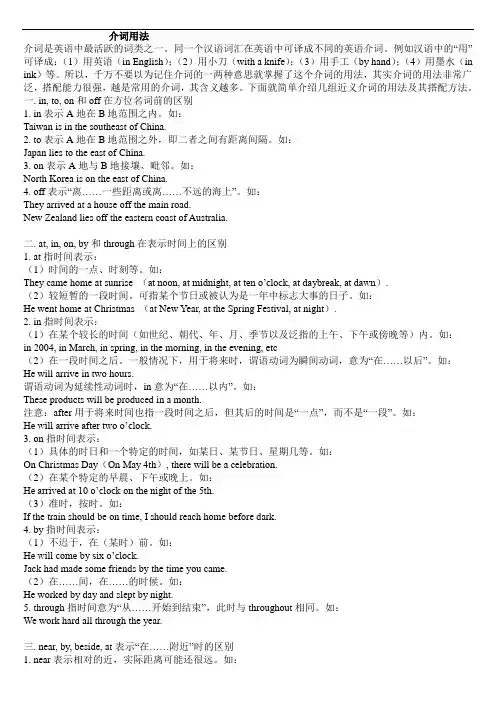
介词用法介词是英语中最活跃的词类之一。
同一个汉语词汇在英语中可译成不同的英语介词。
例如汉语中的“用”可译成:(1)用英语(in English);(2)用小刀(with a knife);(3)用手工(by hand);(4)用墨水(in ink)等。
所以,千万不要以为记住介词的一两种意思就掌握了这个介词的用法,其实介词的用法非常广泛,搭配能力很强,越是常用的介词,其含义越多。
下面就简单介绍几组近义介词的用法及其搭配方法。
一. in, to, on和off在方位名词前的区别1. in表示A地在B地范围之内。
如:Taiwan is in the southeast of China.2. to表示A地在B地范围之外,即二者之间有距离间隔。
如:Japan lies to the east of China.3. on表示A地与B地接壤、毗邻。
如:North Korea is on the east of China.4. off表示“离……一些距离或离……不远的海上”。
如:They arrived at a house off the main road.New Zealand lies off the eastern coast of Australia.二. at, in, on, by和through在表示时间上的区别1. at指时间表示:(1)时间的一点、时刻等。
如:They came home at sunrise (at noon, at midnight, at ten o’clock, at daybreak, at dawn).(2)较短暂的一段时间。
可指某个节日或被认为是一年中标志大事的日子。
如:He went home at Christmas (at New Y ear, at the Spring Festival, at night).2. in指时间表示:(1)在某个较长的时间(如世纪、朝代、年、月、季节以及泛指的上午、下午或傍晚等)内。
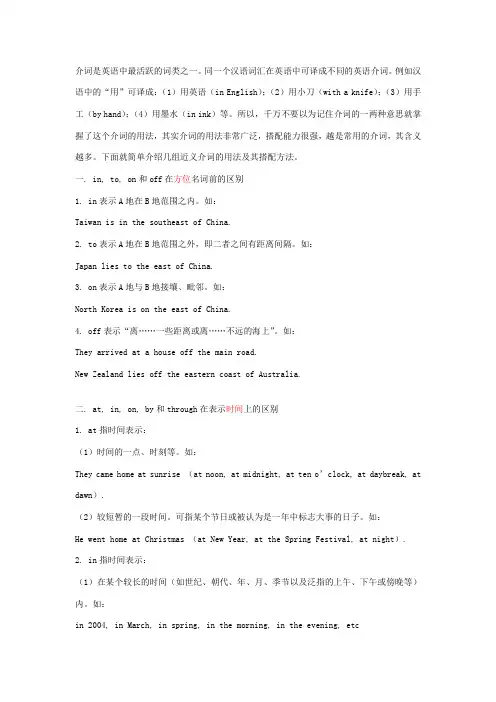
介词是英语中最活跃的词类之一。
同一个汉语词汇在英语中可译成不同的英语介词。
例如汉语中的“用”可译成:(1)用英语(in English);(2)用小刀(with a knife);(3)用手工(by hand);(4)用墨水(in ink)等。
所以,千万不要以为记住介词的一两种意思就掌握了这个介词的用法,其实介词的用法非常广泛,搭配能力很强,越是常用的介词,其含义越多。
下面就简单介绍几组近义介词的用法及其搭配方法。
一. in, to, on和off在方位名词前的区别1. in表示A地在B地范围之内。
如:Taiwan is in the southeast of China.2. to表示A地在B地范围之外,即二者之间有距离间隔。
如:Japan lies to the east of China.3. on表示A地与B地接壤、毗邻。
如:North Korea is on the east of China.4. off表示“离……一些距离或离……不远的海上”。
如:They arrived at a house off the main road.New Zealand lies off the eastern coast of Australia.二. at, in, on, by和through在表示时间上的区别1. at指时间表示:(1)时间的一点、时刻等。
如:They came home at sunrise (at noon, at midnight, at ten o’clock, at daybreak, at dawn).(2)较短暂的一段时间。
可指某个节日或被认为是一年中标志大事的日子。
如:He went home at Christmas (at New Year, at the Spring Festival, at night). 2. in指时间表示:(1)在某个较长的时间(如世纪、朝代、年、月、季节以及泛指的上午、下午或傍晚等)内。
介词用法知多少介词是英语中最活跃的词类之一。
同一个汉语词汇在英语中可译成不同的英语介词。
例如汉语中的“用”可译成:(1)用英语(in English);(2)用小刀(with a knife);(3)用手工(by hand);(4)用墨水(in ink)等。
所以,千万不要以为记住介词的一两种意思就掌握了这个介词的用法,其实介词的用法非常广泛,搭配能力很强,越是常用的介词,其含义越多。
下面就简单介绍几组近义介词的用法及其搭配方法。
一. in, to, on和off在方位名词前的区别1. in表示A地在B地范围之内。
如:Taiwan is in the southeast of China.2. to表示A地在B地范围之外,即二者之间有距离间隔。
如:Japan lies to the east of China.3. on表示A地与B地接壤、毗邻。
如:North Korea is on the east of China.4. off表示“离……一些距离或离……不远的海上”。
如:They arrived at a house off the main road.New Zealand lies off the eastern coast of Australia.二. at, in, on, by和through在表示时间上的区别1. at指时间表示:(1)时间的一点、时刻等。
如:They came home at sunrise (at noon, at midnight, at ten o’clock, at daybreak, at dawn). (2)较短暂的一段时间。
可指某个节日或被认为是一年中标志大事的日子。
如:He went home at Christmas (at New Year, at the Spring Festival, at night).2. in指时间表示:(1)在某个较长的时间(如世纪、朝代、年、月、季节以及泛指的上午、下午或傍晚等)内。
“用”可译成:(1)用英语(in English);(2)用小刀(with a knife);(3)用手工(by hand);(4)用墨水(in ink)等。
一. in, to, on和off在方位名词前的区别1. in表示A地在B地范围之内。
如:Taiwan is in the southeast of China.2. to表示A地在B地范围之外,即二者之间有距离间隔。
如:Japan lies to the east of China.3. on表示A地与B地接壤、毗邻。
如:North Korea is on the east of China.4. off表示“离……一些距离或离……不远的海上”。
如:They arrived at a house off the main road.New Zealand lies off the eastern coast of Australia.二. at, in, on, by和through在表示时间上的区别1. at指时间表示:(1)时间的一点、时刻等。
如:They came home at sunrise (at noon, at midnight, at ten o’clock, at daybreak, at dawn).(2)较短暂的一段时间。
可指某个节日或被认为是一年中标志大事的日子。
如:He went home at Christmas (at New Y ear, at the Spring Festival, at night).2. in指时间表示:(1)在某个较长的时间(如世纪、朝代、年、月、季节以及泛指的上午、下午或傍晚等)内。
如:in 2004, in March, in spring, in the morning, in the evening, etc(2)在一段时间之后。
一般情况下,用于将来时,谓语动词为瞬间动词,意为“在……以后”。
in, to, on和off在方位名词前的区别1. in表示A地在B地范围之内。
如:Taiwan is in the southeast of China.2. to表示A地在B地范围之外,即二者之间有距离间隔。
如:Japan lies to the east of China.3. on表示A地与B地接壤、毗邻。
如:North Korea is on the east of China.4. off表示“离……一些距离或离……不远的海上”。
如:They arrived at a house off the main road.New Zealand lies off the eastern coast of Australia.at, in, on, by和through在表示时间上的区别1. at指时间表示:(1)时间的一点、时刻等。
如:They came home at sunrise (at noon, at midnight, at ten o’clock, at daybreak, at dawn). (2)较短暂的一段时间。
可指某个节日或被认为是一年中标志大事的日子。
如:He went home at Christmas (at New Year, at the Spring Festival, at night).2. in指时间表示:(1)在某个较长的时间(如世纪、朝代、年、月、季节以及泛指的上午、下午或傍晚等)内。
如:in 2004, in March, in spring, in the morning, in the evening, etc(2)在一段时间之后。
一般情况下,用于将来时,谓语动词为瞬间动词,意为“在……以后”。
如:He will arrive in two hours.谓语动词为延续性动词时,in意为“在……以内”。
如:These products will be produced in a month.注意:after用于将来时间也指一段时间之后,但其后的时间是“一点”,而不是“一段”。
英语表示地点方位的用法分析(最新版)编制人:__________________审核人:__________________审批人:__________________编制单位:__________________编制时间:____年____月____日序言下载提示:该文档是本店铺精心编制而成的,希望大家下载后,能够帮助大家解决实际问题。
文档下载后可定制修改,请根据实际需要进行调整和使用,谢谢!并且,本店铺为大家提供各种类型的经典范文,如教案大全、教学资料、作文大全、演讲致辞、祝福语、名言句子、感悟故事、心得体会、总结报告、工作计划、党团资料、条据书信、合同协议、其他范文等等,想了解不同范文格式和写法,敬请关注!Download tips: This document is carefully compiled by this editor.I hope that after you download it, it can help you solve practical problems. The document can be customized and modified after downloading, please adjust and use it according to actual needs, thank you!In addition, this shop provides you with various types of classic sample essays, such as teaching plans, teaching materials, essays, speeches, blessings, famous quotes, sentences, insights, experiences, summary reports, work plans, party and group information, and rules Letters, contract agreements, other sample essays, etc. If you want to know the format and writing of different sample essays, stay tuned!英语表示地点方位的用法分析英语表示地点方位的用法分析1、in, to, on, off 在方位名词前的区别1.1、in表示A地在B地范围之内。
英语中常用地点方位词详解一、in,to,on,off 在方位名词前的区别1、in表示A地在B地范围之内。
如:Taiwan is in the southeast of China.2、to表示A地在B地范围之外,即二者之间有间隔。
如:Japan lies to the east of China.3、on表示A地与B地接壤、毗邻。
如:North Korea is on the northeast of China.4、off表示相隔一些距离(尤指海上的距离),经常与coast,seaside,shore等词连用。
如:New Zealand lies off the eastern coast of Australia. 新西兰位于澳洲东海岸附近(隔海)。
二、at,in,on 在不同地点前的区别1、at表示地点,通常表示较小的地方,如:I will wait for you at the station. 此外还用于门牌号码前,如:He lives at115 Zhongshan Road.2、in表示地点,通常表示较大的地方。
如:He lives in Shanghai. 注意:若主人公本身就在那里,那么也可用in表示较小的地方。
以下两例句实际均正确:⑴、I met him at the post-office.⑵、I’m now working in the post-office.3、on表示地点,通常表示与面或线接触,意为“在…上;在…旁”。
如:⑴、The picture was hanging on the wall.⑵、New York is on the Hudson River.三、near,by,beside,at 表示“在…附近”的区别1、near表示相对的近,实际距离有可能很远。
如:Suzhou is near Shanghai.2、by和beside都表示靠近,实际距离不远,但beside比by更具体地表示出“在…旁边”的意思。
i n,t o,o n和o f f 在方位名词前的区别
in, to, on和off在方位名词前的区别
1.in表示A地在B地范围之内。
如:Taiwan is in the southeast of China.
2.to表示A地在B地范围之外,即二者之间有距离间隔。
如:Japan lies to the east of China.
3.on表示A地与B地接壤、毗邻。
如:North Korea is on the east of China.
4.off表示“离……一些距离或离……不远的海上”。
如:They arrived at a house off the main road.
New Zealand lies off the eastern coast of Australia.
at, in, on, by和through在表示时间上的区别
1. at指时间表示:
(1)时间的一点、时刻等。
如:They came home at sunrise (at noon, at midnight, at ten o’clock, at daybreak, at dawn).
(2)较短暂的一段时间。
可指某个节日或被认为是一年中标志大事的日子。
如:He went home at Christmas (at New Year, at the Spring Festival, at night). 2. in指时间表示:
(1)在某个较长的时间(如世纪、朝代、年、月、季节以及泛指的上午、下午或傍晚等)内。
如:in 2004, in March, in spring, in the morning, in the evening, etc
(2)在一段时间之后。
一般情况下,用于将来时,谓语动词为瞬间动词,意为“在……以后”。
如:He will arrive in two hours.
谓语动词为延续性动词时,in意为“在……以内”。
如:These products will be produced in a month.
注意:after用于将来时间也指一段时间之后,但其后的时间是“一点”,而不是“一段”。
如:He will arrive after two o’clock.
3. on指时间表示:
(1)具体的时日和一个特定的时间,如某日、某节日、星期几等。
如:On Christmas Day(On May 4th), there will be a celebration.
(2)在某个特定的早晨、下午或晚上。
如:He arrived at 10 o’clock on the night of the 5th.
(3)准时,按时。
如:If the train should be on time, I should reach home before dark.
4. by指时间表示:
(1)不迟于,在(某时)前。
如:He will come by six o’clock.
Jack had made some friends by the time you came.
(2)在……间,在……的时候。
如:He worked by day and slept by night.
5. through指时间意为“从……开始到结束”,此时与throughout相同。
如:We work hard all through the year.
at, in和on表示地点时的区别
1. at表示地点:
(1)用于指较小的地方。
如:I shall wait for you at the station.
(2)用于门牌号码前。
如:He lives at 115 Zhongshan Road.
2. in表示地点:
(1)用于指较大的地方。
如:He lives in Shanghai.
(2)虽然是很小的地方,如果说话人住在那里,也可用in。
商店、学校、机关等,若看作一个地点(point)用at,若看作一个场所(place)用in。
如:I met him at the post-office.
I’m now working in the post-office.
3. on表示地点,一般指与面或线接触,意为“在……上;在……旁”。
如:The picture was hanging on the wall.
New York is on the Hudson River.
above, over, on, up表示“在……上”之间的区别
1.above指“……上方”,表示相对高度,不一定在正上方,其反义词为below。
如:We’re flying above the clouds.
2. over指“在……正上方”,表示垂直上方,其反义词为under。
如:The bridge is over the river.
3. on表示“在……上面”,与物体表面接触,与beneath相对。
如:There is a map on the wall.
The earth felt soft beneath our feet.
4. up表示动作的方向往上,反义词为down。
如:Please hang the picture up.。